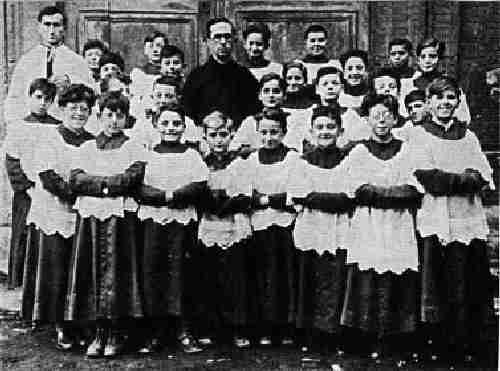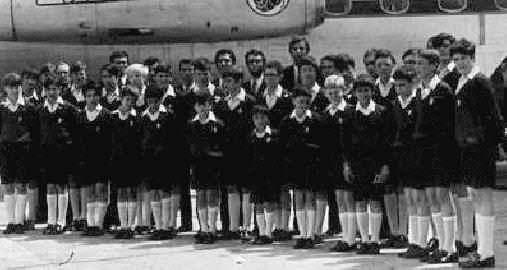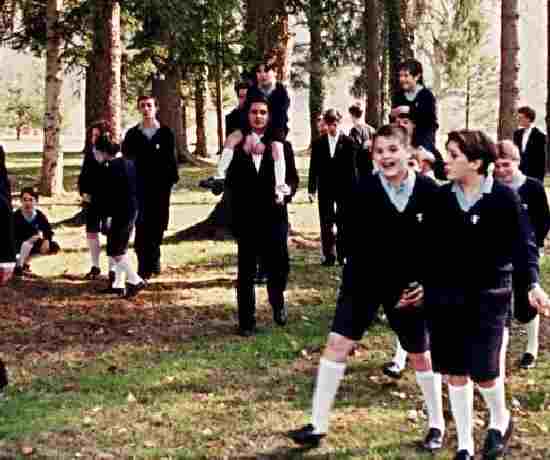
Figure 1.--It was 60 years ago: the abbot George Rey created a choir in 1936. [There in the medium of other small singers of the whole world in 1947 and always many in 1949???]


Figure 1.--It was 60 years ago: the abbot George Rey created a choir in 1936. [There in the medium of other small singers of the whole world in 1947 and always many in 1949???] |
The "Manécanterie of with the Potencée Cross" was originally named "Manécanterie des Petits Chanteurs à la Coix Potencée" (The Little Singers with the Potencée ("gibbeted") Cross. It is an an association created with non-profit, cultural and educational goals. The choir seeks to to promote the religious and beautiful secular music and to diffuse musical works.
La Manécanterie d was founded in 1936 by Abbot George Rey in the spirit of the choirs whose tradition goes back in France to 13th century. Groups of children at that time received a musical formation and provided a liturgical function. The name of "Manécanterie" indicates that they sang the offices of mass in the morning, then to the [wire??] of the centuries, their role extended, through the polyphonic music. These choirs are today quite rare. The foundation of the Manécanterie des Petits Chanteurs à la Croix Potencée was influenced by the example of La Manécanterie des Petits Chanteurs à la Croix de Bois. Les Petits Chanteurs à la Croix Potencée in 1940 joined the International Federation of Pueri Cantores. The Choir has travelled throughout the world, widened its repertory with the profane song and for a few years, with the lyric art by its participation in grand operas with famous Théâtre of Capitole.
Various recordings mark out the history of Manécanterie, lastly a compact disc of ten titles and a recording with the tenor Roberto Alagna under the direction of
Michel Plasson, director of the National Orchestra of Capitole of Toulouse.

Figure 2.--A beautiful voyage in 1970: England. |
The manecantery that the small singers call "Mané", sets up a group of about 30 young boys, schoolboys, schoolboys, high-school pupils or students. " If they have voice, so much better, if not we will give it to them. He was known as Abbot Rey. He has been folowed by several succesor choir heads.
The small singer is admitted without particular musical knowledge. It will be formed with the choir singing, more by the practice and the exercise that by a theoretical
teaching. He will be introduced to the great sacred music as well as secular music. The program includes Gregorian chant with the traditional polyphony of 15th and 16th centuries and contemporary works.
The new child and schoolboy alike like his predecessors repeats two or three times per week. Very quickly, he takes part in the concerts and the masses which the Choir holds everywhere in Toulouse and the surrounding area. During the school holidays, the Choir goes on 1-3 weeks in France and abroad. The small singers are lodged with host families and share a collective life. Along with the concerts the boys participate in sports activities, visit important tourist sites and alsp participate in pontifical or royal reception.

Figure 3.--1996 : The 60th anniversary celebration. |
In 1996, at the time of a round of spring in Haute-Savoie, happy children to sing and share moments of relaxation the abbot George Rey continues to take care on the
destiny of the Small Singers.
At the time of the international congress of Pueri Cantores of Rome in 1993, the Small Singers meet His Holiness Jean-Paul II.
I am not sure what the Choir wore when it was originally founded. Photographs after World War II show then wearing a white shirt without a tie, blur sweater with choir badge, matching blue short pants, white kneesocks, and balck shoes. This uniform was worn at several private Catholic schools in Belgium and France.
Thecabove text is based on this French text. Please let HBC know if you have any suggestios about the transdlation.
La Manécanterie des Petits Chanteurs à la Croix Potencée est une association créée en application de l'article 5 de la loi du 1er juillet 1901. C'est une association à but non lucratif, culturel et éducatif, qui veut promouvoir le chant religieux et profane et
diffuser de belles uvres musicales.
Cette «uvre» a été fondée en 1936 par l'abbé Georges Rey dans l'esprit des maîtrises dont la tradition remonte en France au XIIIe siècle. Ces groupes d'enfants recevaient une formation musicale et assuraient une fonction liturgique ; le nom de « Manécanterie »
indique qu'ils chantaient les offices du matin, puis au fil des siècles, leur rôle s'est étendu, au travers de la musique polyphonique. Rares sont aujourd'hui ces maîtrises de jeunes garçons. La manécanterie des Petits Chanteurs à La Croix Potencée est ainsi devenue, peu après sa création, une filiale du groupe des Petits Chanteurs à la Croix de Bois, et elle adhère depuis 1940 à la Fédération internationale des Pueri Cantores. Elle a voyagé à travers le monde, élargi son répertoire au chant profane et depuis quelques années,
à l'art lyrique par sa participation à de grands opéras avec le célèbre Théâtre du Capitole.
Divers enregistrements jalonnent l'histoire de la Manécanterie, en dernier lieu un compact disque de dix titres et un enregistrement avec le ténor Roberto Alagna sous la direction de Michel Plasson, directeur de l'Orchestre National du Capitole de Toulouse.
Veuillez cliquer sur les images pour les visualiser pleinement
La manécanterie que les petits chanteurs appellent « la Mané », constitue un groupe d'une trentaine de jeunes garçons, écoliers, collégiens, lycéens ou étudiants. «S'ils ont de la voix, tant mieux, sinon nous la leur donnerons » dit l'abbé REY, auquel ont succédé maintenant plusieurs chefs de chœur.
Le petit chanteur est admis sans connaissance musicale particulière. Il sera formé au chant choral, plus par la pratique et l'exercice que
par un enseignement théorique. Il découvrira les grandes uvres de la musique religieuse et profane, du chant grégorien à la polyphonie classique des XVe et XVIe siècles, et jusqu'aux uvres contemporaines.
Enfant et écolier comme les autres, il répète deux ou trois fois par semaine. Très vite, il participe aux concerts et aux messes que la Manécanterie anime partout à Toulouse et dans sa région. Durant les vacances scolaires, la Manécanterie effectue des tournées d'une
à trois semaines en France et à l'étranger. Les petits chanteurs sont hébergés dans des familles d'accueil et partagent une vie collective où les concerts alternent, pour leur plus grand bonheur, avec les activités sportives, la visite du patrimoine et des événements aussi
marquants qu'une réception pontificale ou royale.
Navigate the Historic Boys' Clothing Web Site:
[Introduction]
[Chronologies]
[Style Index]
[Biographies]
[Bibliographies]
[Biographies]
[Activities]
[Countries]
[Boys' Clothing Home]
Navigate the Historic Boys' Clothing Web choir costume pages:
[Return to the Main choir page]
[Return to the Main national choir page]
[Australia]
[Austria]
[Belgium]
[Bulgaria]
[Canada]
[Denmark]
[England]
[France]
[Finland]
[Germany]
[Japan]
[Netherlands]
[Poland]
[South Africa]
[United States]
Navigate the Historic Boys' Clothing Web style pages:
[Short pants suits]
[Blazers]
[Collars]
[Lace collars]
[Ruffled collars]
[Eton collar]
[Fauntleroy suits]
[Sailor suits]
[Ring bearer/page costumes]
[First Communion suits]
